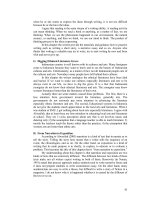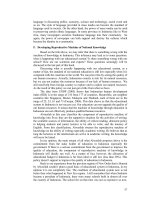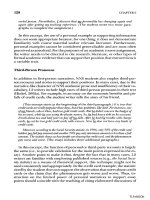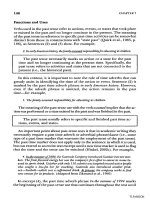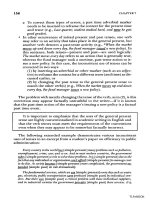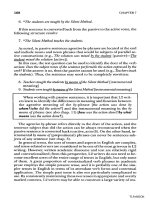Tài liệu Teaching and learning english part 16 pdf
Bạn đang xem bản rút gọn của tài liệu. Xem và tải ngay bản đầy đủ của tài liệu tại đây (465.32 KB, 10 trang )
106
treatment, it means that the strategy is not effective way to increase the students’
reading comprehension. After all, the findings obtained will be in the form of
score from which the ultimate result is interpreted and can be generalized.
References:
Aderson, et al. (1969). Efficient Reading: Practical Guide. Sidney: MC Graw Hill-
Book Company
Ariwiyati. (1997).
Course Outline Senior High School Textbooks. Penataran Guru
Inti MAN Model Bidang Studi Bahasa Inggris Se Indoinesia. Malang: UUM
Malang.
Grabe, Wiliam. et al (2002).
Teaching and Researching Reading. New York:
Longman.
Kemmis, Stephen et al. ( 1981)
Principles an Procedure in Curriculum Evaluation.
Journal of Curriculum Studies, Vol 13, no 2, April-June, Pages 151-155.
Leininger, Madeleine. (1985).
Qualitative Research Methods in Nursing. Orlando:
Grune and Stratton
107
SEQUENCE AND COMMENT ON THE STORY FOR YOUNG
LEARNERS
Muhammad Sukrianto
It has been recognize that story telling is interesting for children world, since it
can train to process the problem in children’s mind. There are so many interesting
stories that suitable for the world of children according to what mission the story teller
want to tell. In EFL learning, the teacher or the story teller should form the particular
content of the story. In evaluating the story, to tell to the children, we should pay
attention on the following criteria:
1. The story should be attractive,
2. The story should be entertaining,
3. The story should not be too long,
4. The story should be functional, grammatical, and accessible
5. The story teller should use language expression in context or language body,
6. The story should contain imagination or animation,
7. The story introduce a new language
8. The story recycle the language,
9. The language level of the story is suitable for the children,
10. The illustration supports the language, etc.
Among of seven stories which have been discussed before, I want to set the stories
based on the important one to tell to the children and the things which are explored.
1.
“Three Little Mice”.
The story tells about three little mice which live in a mushroom house. The older
mouse is a diligent one, while the middle and the youngest are very lazy. They just
like playing and eating. Since the oldest mouse is diligent, it can have meal to eat,
while both others do not have meal to eat so that they go to the cat’s house to steal
food. Unfortunately they are caught by cat and put them into a cage. Although both
of them are lazy, their oldest brother comes to help them to get out of there. Finally
the lazy mice realized that laziness can make them misfortune.
Some reasons that lead me to place this story at the first line of others are:
1. The concept of accessibility; 1) it is familiar since its character is animal, mouse,
2) it is simple story as it uses the high frequent words, and 3) it uses good
grammar which is important for young learners living in less exposure
circumstance.
2. The concept of exploitability; 1) repetition of words and expressions, 2)
sequence of time, such as one day, the next day, the following day, and
functional expressions.
3. The visual attraction; it uses colorful pictures which mostly attract children’s
attention.
4. Imaginative story; it is also interesting for children.
For the kindergarten school children this story is rather long, but the rich contains
makes me interested in choosing it. Therefore, the teacher or the story teller has to
have the strategies to choose and present what part to focus on.
1. It contains of repetition of the words and sentences, such as:
108
a. “Come on, who wants to help brother Tiko” (three times),
b. “I am sorry, we can not help you, brother Tiko, we are playing” (three
times),
c. Tiko went alone…the apple tree in garden (also three times).
2. Since the story has some illustration pictures, the teacher or the story teller can
show them some kinds of pictures like colors, how to plant a plant, how to water
a plant, and how to fertilize a plant.
3. It has the different characters-diligent and lazy.
4. 4. It has sequences of the time, such as one day, the following day, and finally.
5. The consequence is being diligent and lazy mice.
2. “Scat! Scat!, Little Cat”
The story tells about a little cat that has no home to stay. Wherever it goes , a little
cat found that it was chased away by the owner of the house. At last a little cat could
find a home to stay after a little girl took it to her home. In this story, the teacher or
the story teller wants to tell:
a. The concept of accessibility; 1) it is familiar since the topic is about pet, cat, 2) it
uses good grammar which is important for young learners living in less exposure
circumstance.
b. The concept of exploitability; 1) repetition of words, e.g. little, and 2) functional
expressions, e.g. scat, scat go away little cat.
c. The visual attraction; it uses colorful pictures which mostly attract children’s
attention.
d. Imaginative story; it is also interesting for children.
I put this story in the second arrangement for the reason that it possesses less
exploitability compared to the first one.
a. Loving the animal (a little cat).
b. Introduce some words by having repetition words, like scat, scat, a little cat
c. Describe a white cat and its picture
d. Describe the old woman who dislike the cat, and a little girl who like cat.
3.
“A Little Green Leaves”
The story tells about the green leaves in the autumn. When the autumn comes one
by one of little green leaves turn ground and fell into the ground, except one. It fells
lonely on the tree, but at last, a bird took and put it into the ground, so that it felt
comfortable with its brothers and sisters.
The teacher or the story teller wants to tell about autumn season when all green
leaves will change become brown and fell into the ground. But the children will
probably fell confused to autumn season because Indonesian children do not know
what exactly autumn is, since Indonesia just has two seasons, rainy and dry. In this
case, the story teller should change the autumn with the dry season. The things
which can be explored by this story are:
a. The concept of accessibility; 1) it is familiar to the children, the leaf, 2) it is
simple in line with the form of language use and the length, and 3) it uses good
grammar which is important for young learners living in less exposure of that
language.
b. The concept of exploitability; 1) repetition words, like little green leaf, and 2)
functional expressions, such as autumn is coming, yippee, go ahead, jump.
109
c. The visual attraction; it uses colorful pictures which mostly attract children’s
attention.
d. Imaginative story; it is also interesting for children. However, the context of this
story is abstract for children since it tells about autumn and spring which
unfamiliar with them. The strange context requires the teacher to expose more
information to make the children more familiar with the context.
e. A season when all green leaves turn down to brown
f. The happiness of little green leaf live together with its brothers and sisters
4. “The Chickens Take a Holiday”
The story tells about Tim’s farm where there are five chickens and ten cows. The
dialogue between chickens and cows talk about taking a holiday after they work
hard to give the farmer ten eggs and one hundred pails of milk. But at last Tim, the
owner of chickens and cows felt tired after working hard a week and he wants to
take a holiday that week. The things can be explored are:
a. The concept of accessibility; 1) the character, animal, is familiar to the children,
2) it is simple in line with the form of language use, and 3) it uses good
grammar.
b. The concept of exploitability: it uses the functional expressions, like; oh
handsome crow, can you sing.
c. Imaginative story; it is also interesting for children.
There are two reasons why I put this story at the forth rank. Firstly, the presentation
of the story lacks of colorful pictures which makes it less virtual in concept.
Secondly, the story needs an analysis process so quite difficult that the children can
catch the idea of the story.
5. “
Who is the king of the forest?”
a. The concept of accessibility; 1) it is familiar to the children since it talks about
animal character, 2) it is simple whether the language use and the length of the
story, and 3) it uses good grammar which is important for children living in less
exposure of that language.
b. The concept of exploitability; it uses some functional expression which
comprises the body response, e.g. jump.
c. Imaginative story; it is also interesting for children.
Actually, this story is not so far different from the fourth one. I place this story at
the fifth place since it possesses some weaknesses, such as: 1) the concept of virtual
is abstract for children so it is less attractive for them, 2) the plot of the story needs
analysis ability which force the children to think deeply to understand the story or
even they may get nothing, and 3) it’s quite long compared to the fourth one.
6. “The chicken take a holiday”
The concept of accessibility; it uses good grammar due to the importance of which
to be exposed to the children who live in less exposure of that language.
a. The concept of exploitability; it uses some functional expressions, like go right,
go left, and introduces part of body.
b. Imaginative story; it is also interesting for children.
110
This story is placed at the sixth rank for several reasons, they are: 1) it presents
abstract context which is believed to be difficult for the children to get the point of
the story, 2) it is long story which also becomes the encounter for children’s
comprehension, and 3) the use of language introduced is high level for children.
7. “Tom thumb”
a. The concept of accessibility; 1) it is familiar to the children which tells about the
animal character, and 2) it uses good grammar which is very important for
children who live in less exposure of the target language.
b. The concept of exploitability; 1) repetition words, like taking holiday, 2)
concept of number, like; five, ten, 100 pails, and 3) functional expressions like;
enjoy your day off, call him again.
c. Imaginative story; it is also interesting for children.
This story becomes the last to be presented in this arrangement because; 1) the
presentation of the story lacks of colorful pictures which makes it less virtual in
concept, 2) the concept of number introduced is fairly high level for beginners, 3)
the story is long that cause the children difficult to follow, and 4) the learners’
comprehension of the story can be reached only if the children have mastered
certain number of vocabularies.

